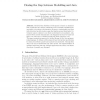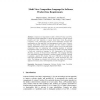SLE
2009
Springer
14 years 7 months ago
2009
Springer
Abstract. Model-Driven Software Development is based on standardised models that are refined, transformed and eventually translated into executable code using code generators. How...
SLE
2009
Springer
14 years 7 months ago
2009
Springer
Composition of requirements models in Software Product Line (SPL) development enables stakeholders to derive the requirements of target software products and, very important, to re...
SLE
2009
Springer
14 years 9 months ago
2009
Springer
SLE
2009
Springer
14 years 9 months ago
2009
Springer
SLE
2009
Springer
14 years 9 months ago
2009
Springer
Abstract. API migration refers to adapting an application such that its dependence on a given API (the source API) is eliminated in favor of depending on an alternative API (the ta...
SLE
2009
Springer
14 years 9 months ago
2009
Springer
Modularisation can reduce the effort in designing and maintaining language specifications. Existing approaches to language modularisation are typically either focused on language ...
SLE
2009
Springer
14 years 9 months ago
2009
Springer
SLE
2009
Springer
14 years 9 months ago
2009
Springer
Feature modeling is a widely used technique in Software Product Line development. Feature models allow stakeholders to describe domain concepts in terms of commonalities and diffe...
SLE
2009
Springer
14 years 9 months ago
2009
Springer
In consequence of changing requirements and technological progress, software languages are subject to change. The changes affect the language’s specification, which in turn a�...
SLE
2009
Springer
14 years 9 months ago
2009
Springer
As domain-specific modeling begins to attract widespread acceptance, pressure is increasing for the development of new domainspecific languages. Unfortunately these DSLs typicall...


